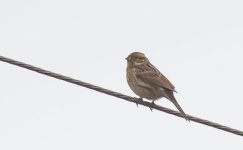Sorry to disagree Butty, but it's definitely a clue (behaviour, typical or atypical is always useful). Not sure it can be given a huge amount of weight, but then neither can anything else in this ambivalent photo it seems!
We don't have the OP to ask, but it would make more of a sizeable difference if we knew whether the bird was perched singing on the wire, or had just been flushed up by them and perched fleetingly for example.
(My experience may be limited, but don't recall seeing Reed Buntings on wires either - they tend to be much lower)





